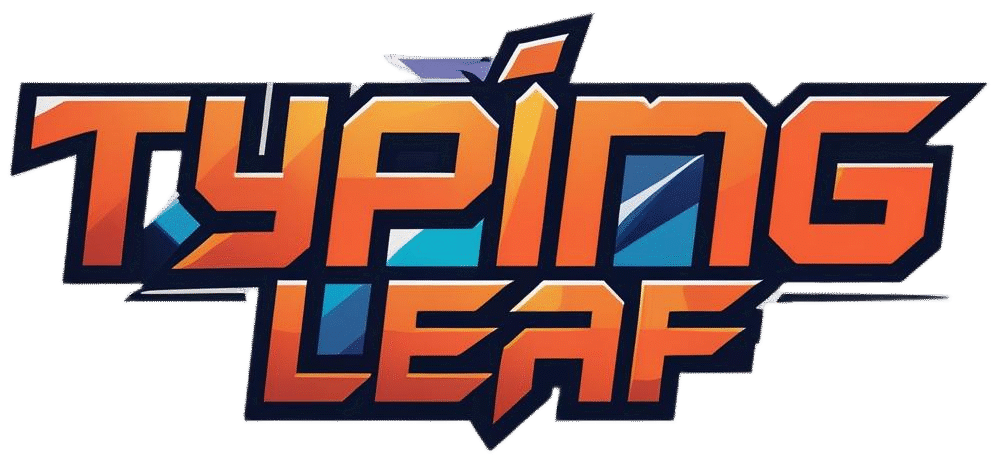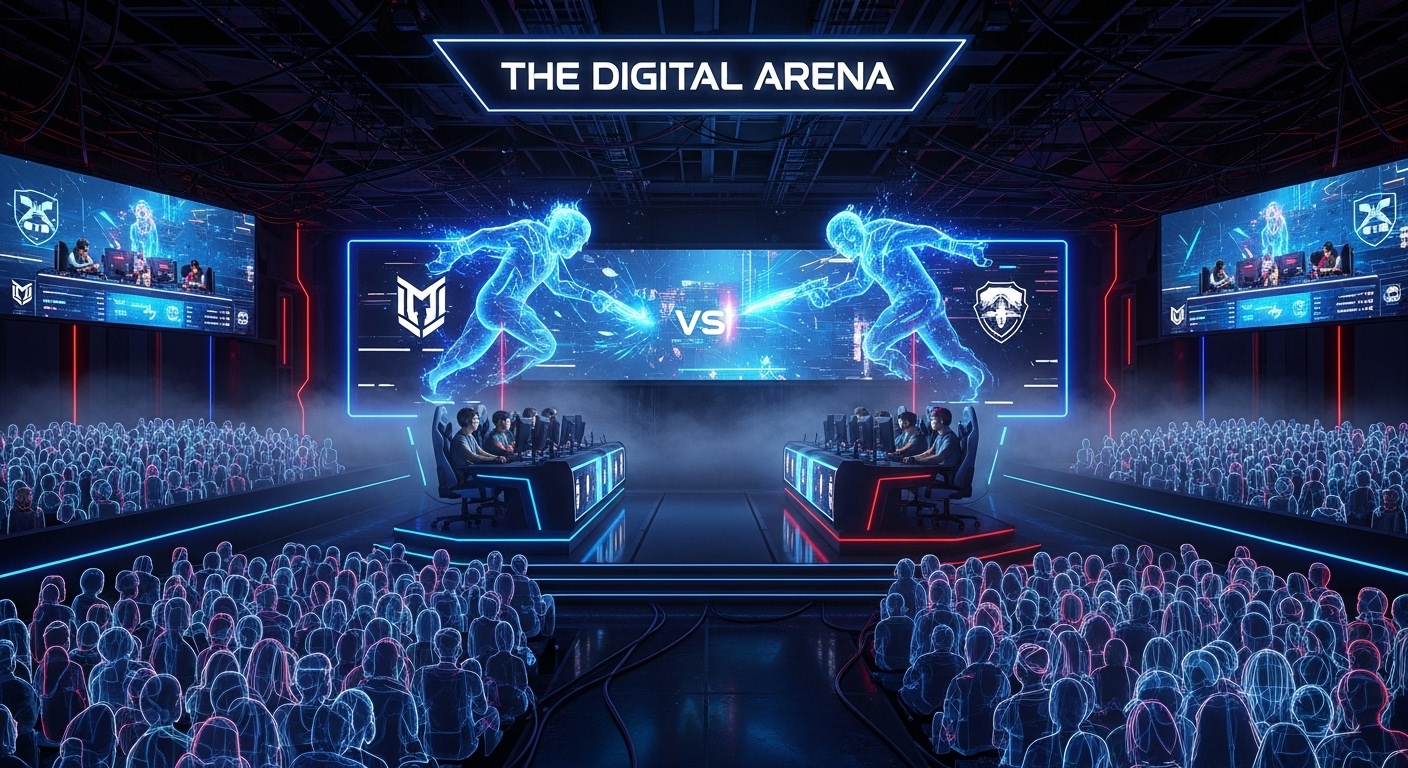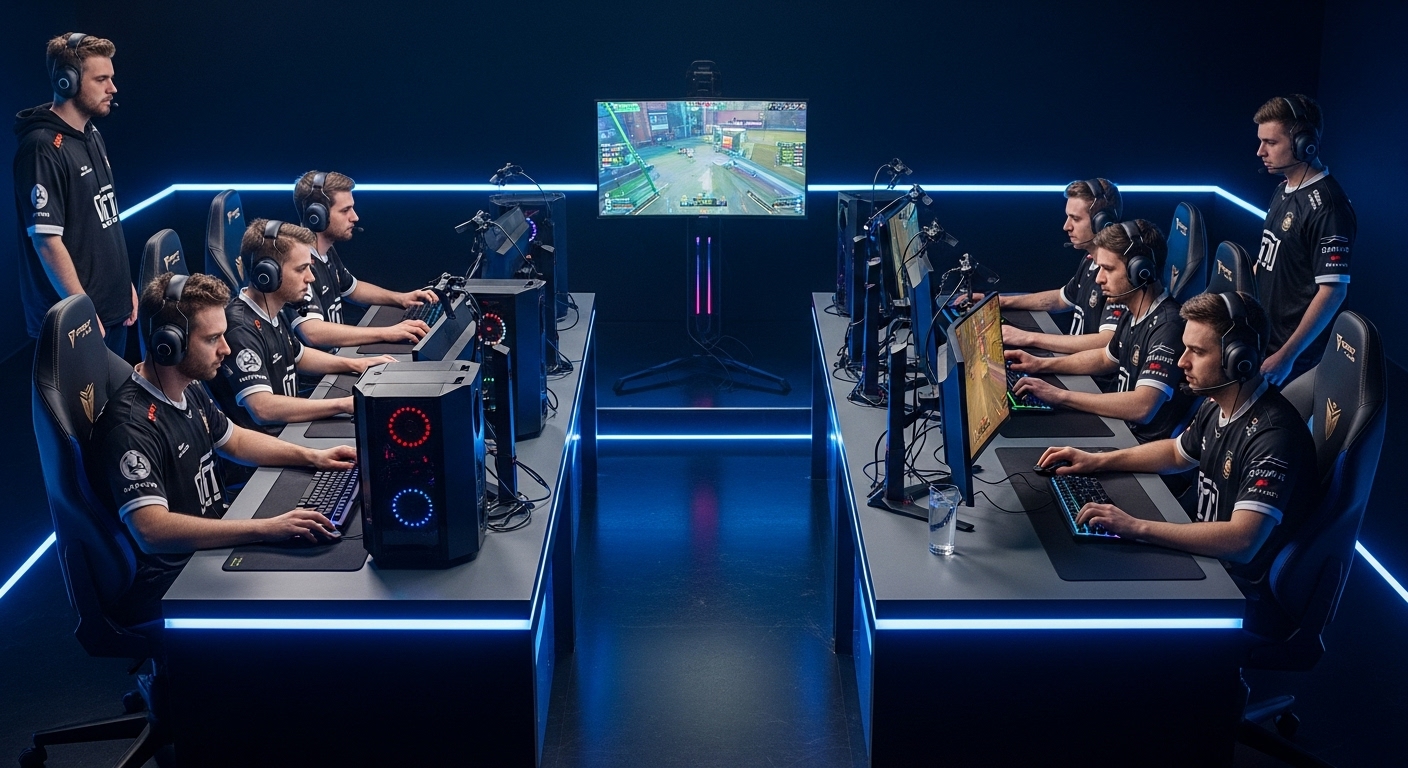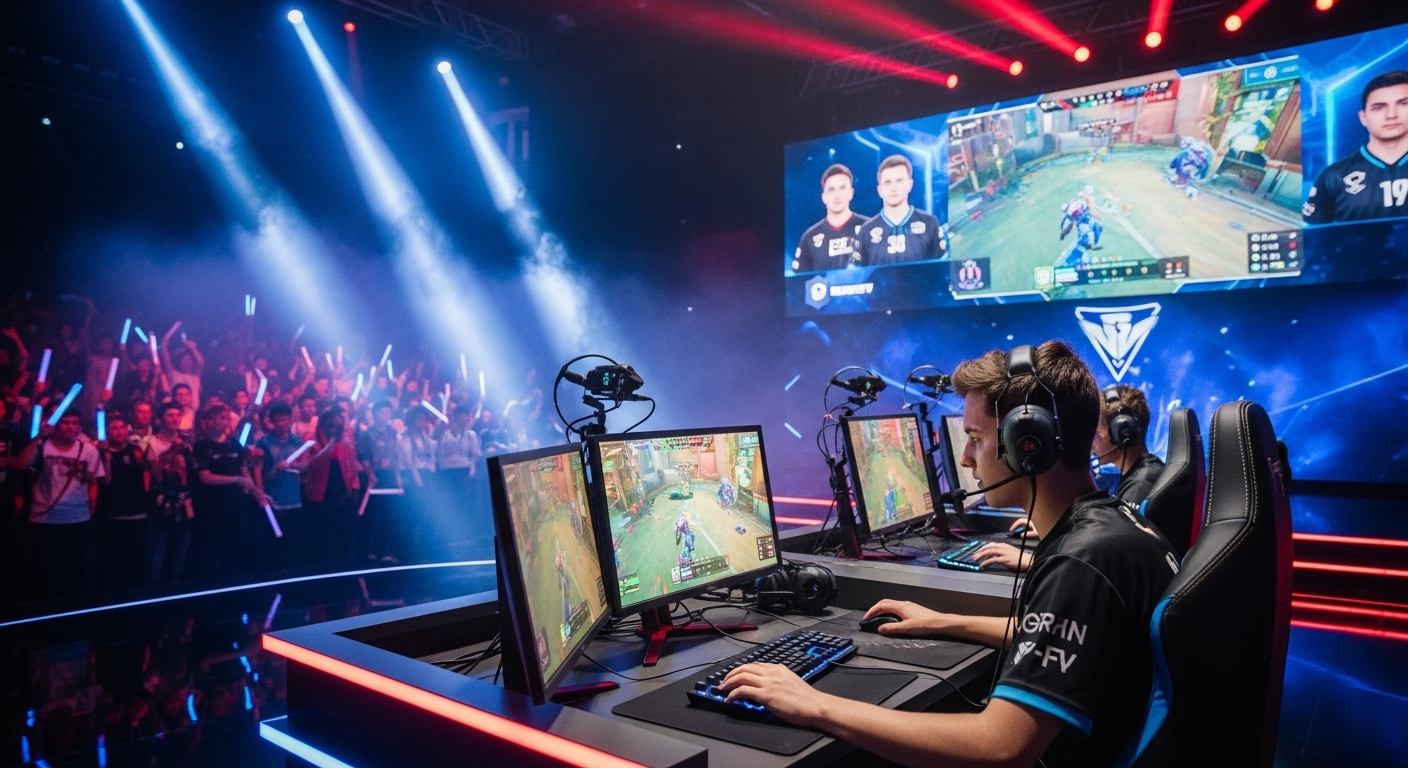Introduction
Over the last two decades, few industries have transformed as rapidly and dramatically as Esports. What began as small-scale competitions between friends in crowded internet cafés has evolved into a multi-billion-dollar global industry that rivals traditional sports in popularity, scale, and influence. Esports — or electronic sports — represent competitive video gaming at a professional level, with players and teams training, strategizing, and competing for fame, fortune, and pride. It’s more than just gaming; it’s a cultural movement that has redefined entertainment, technology, and even career aspirations for millions worldwide.
The Origins of Competitive Gaming
The roots of Esports stretch back to the 1970s and 1980s when the earliest video game tournaments were held. One of the first recognized competitions took place at Stanford University in 1972, where students competed in a game called Spacewar. The prize was modest — a year’s subscription to Rolling Stone magazine — but the event set a precedent for organized video game competition. As arcades became popular in the 1980s, high score competitions on games like Pac-Man, Donkey Kong, and Space Invaders started drawing public attention. Players would battle for bragging rights and local fame, long before global tournaments and sponsorships were even imaginable.
The 1990s marked a pivotal moment. With the rise of home consoles and personal computers, multiplayer gaming began to flourish. Titles like Doom and Quake introduced local and online multiplayer modes, and LAN (Local Area Network) parties became common. These gatherings were the early precursors of modern Esports tournaments, where players connected their computers to compete in first-person shooters or strategy games.
The Birth of Modern Esports
The real breakthrough for Esports came in the late 1990s and early 2000s. Internet connectivity improved, allowing players to compete with others across the globe. South Korea, in particular, played a crucial role in shaping the Esports landscape. During the Asian financial crisis, the South Korean government heavily invested in broadband infrastructure, which inadvertently fueled the growth of competitive gaming. Games like StarCraft became national sensations, and professional players like Lim “BoxeR” Yo-hwan rose to celebrity status. Televised matches, team sponsorships, and fan clubs became part of the culture, establishing the framework for what Esports would become globally.
In the West, competitive scenes emerged around titles such as Counter-Strike, Warcraft III, and Halo. Online platforms like Battle.net, MLG (Major League Gaming), and the World Cyber Games provided early competitive structures. These events were not only about competition but also about community. Players and fans connected online, discussing strategies and sharing highlights. This digital ecosystem laid the foundation for the explosion that followed in the next decade.
The Explosion of Esports in the 2010s
The 2010s can be considered the golden decade of Esports. With the rise of streaming platforms such as Twitch and YouTube Gaming, competitive gaming became accessible to anyone with an internet connection. Viewers could watch tournaments, learn from professionals, and even follow their favorite players in real-time. This accessibility transformed Esports into a mainstream form of entertainment.
Games like League of Legends, Dota 2, and Counter-Strike: Global Offensive became staples of competitive gaming. Riot Games’ League of Legends World Championship, for instance, drew millions of viewers annually, with production quality rivaling that of major sporting events. The International, Dota 2’s annual tournament, broke records for prize pools, reaching tens of millions of dollars funded by community contributions.
Meanwhile, first-person shooters like Overwatch and battle royale games such as Fortnite brought Esports to an even younger audience. Fortnite’s 2019 World Cup, where a 16-year-old player won $3 million, showcased the potential for gaming to be a legitimate career path. The spectacle of large-scale tournaments, live audiences, and multi-million-dollar sponsorships solidified Esports as a major entertainment industry.
The Rise of Professionalism and Infrastructure
As the industry grew, so did its structure and professionalism. Esports teams began operating like traditional sports franchises, with coaches, analysts, nutritionists, and marketing staff. Players underwent rigorous training schedules, practiced team coordination, and studied their opponents’ gameplay footage. Major organizations such as Cloud9, Fnatic, T1, and Team Liquid became household names, building brands around excellence and fandom.
Esports organizations also attracted investment from traditional sports teams and celebrities. NBA franchises like the Philadelphia 76ers and football clubs such as Paris Saint-Germain established Esports divisions. This crossover validated Esports as a legitimate business and cultural enterprise. Sponsorships from major brands — including tech giants, beverage companies, and apparel lines — poured in, giving the industry financial stability and visibility.
Beyond competition, infrastructure development became a priority. Dedicated Esports arenas were built across the world, including the Esports Stadium Arlington in Texas and the LCK Arena in Seoul. These venues serve as hubs for tournaments, fan events, and training facilities. Universities and colleges also joined in, offering Esports scholarships and establishing varsity teams, recognizing the potential of Esports both as a competitive pursuit and an academic discipline.
The Role of Technology in Shaping Esports
Esports wouldn’t exist without technology, but its advancement has been particularly crucial in shaping the modern industry. High-speed internet, powerful gaming hardware, and broadcasting technology have enabled the seamless experience fans and players enjoy today. Streaming platforms have become digital arenas, allowing millions to tune in to live matches. Real-time chat, interactive overlays, and AI-based analytics enhance the viewer experience.
Virtual reality (VR) and augmented reality (AR) are also beginning to influence Esports. While still in early stages, these technologies promise to bring immersive experiences that blend physical and digital competition. Cloud gaming, powered by services like NVIDIA GeForce Now and Xbox Cloud Gaming, is making competitive play more accessible, reducing the barrier of expensive gaming equipment.
AI and data analytics are transforming how teams prepare and compete. Coaches use data to study opponent patterns, analyze player reactions, and optimize strategies. The integration of technology in Esports isn’t just about performance; it’s about redefining how people engage with entertainment.
Esports and the Global Audience
One of the defining features of Esports is its global appeal. Traditional sports often have regional followings — soccer in Europe and South America, basketball in North America, cricket in Asia — but Esports transcends borders. A League of Legends match can feature a South Korean team competing against a European or Chinese one, with fans from dozens of countries watching simultaneously.
Language barriers are fading as tournaments offer multi-language broadcasts and subtitles. Communities form around teams, not geography, uniting fans worldwide. This universal accessibility has helped Esports grow into a global cultural movement. Events like the League of Legends World Championship and the Intel Extreme Masters in Katowice attract fans from every continent, proving that digital competition can unite people as powerfully as physical sports.
The Economic Impact of Esports
The financial growth of Esports is staggering. Industry reports estimate its market value in the billions, with revenues coming from sponsorships, media rights, ticket sales, and merchandise. Prize pools for major tournaments often exceed those of established sports events, signaling the immense financial potential.
Brands see Esports as a way to reach younger, tech-savvy audiences who consume digital content differently than previous generations. Unlike traditional advertising, Esports marketing often integrates organically through partnerships with players, teams, or streamers. This authenticity makes Esports sponsorships particularly effective.
Additionally, Esports creates thousands of jobs — not only for players and coaches but also for event organizers, broadcasters, content creators, and developers. Entire ecosystems have developed around gaming merchandise, live event production, and digital media, contributing significantly to the creative economy.
Esports and Education
The academic world has begun to recognize Esports as more than just a pastime. Many universities now offer Esports management, broadcasting, and game design programs. Students can study the business, technology, and psychology behind competitive gaming, preparing for careers in a fast-growing field.
Some institutions even offer Esports scholarships, treating top players with the same prestige as athletes in traditional sports. These programs foster teamwork, strategic thinking, and leadership — skills valuable in any profession. Educational acceptance has helped reduce the stigma surrounding gaming, reframing it as a legitimate pursuit that blends creativity, skill, and innovation.
Challenges in Esports
Despite its rapid growth, Esports faces significant challenges. Player burnout is a serious concern, as intense practice schedules and constant travel can take a toll on mental and physical health. Unlike traditional sports, where athletes have off-seasons, Esports often run year-round, with overlapping tournaments and constant online play.
Another issue is regulation. Since Esports span multiple countries and game titles, there’s no single governing body overseeing rules, player rights, or competitive integrity. Match-fixing, cheating, and player exploitation have surfaced in some cases, prompting calls for stronger governance and ethical standards.
Diversity and inclusion are also ongoing challenges. While gaming is universal, professional Esports remains male-dominated, with limited female representation at the top levels. Initiatives to promote inclusivity are growing, but progress is slow. Creating a safe, welcoming environment for all players remains a priority for the industry’s long-term health.
The Cultural Influence of Esports
Esports have influenced more than gaming; they’ve reshaped culture. Professional players are now celebrities, with massive online followings and brand endorsements. Gaming content has become part of mainstream media, with documentaries, series, and even films exploring the competitive gaming lifestyle.
Music, fashion, and entertainment have merged with Esports. Collaborations between gaming companies and artists — from in-game concerts to custom apparel — highlight how deeply gaming has integrated into pop culture. Events like the League of Legends opening ceremonies blend live performance, animation, and digital effects in ways no other medium can match.
Esports have also impacted how young people view careers. The idea of becoming a professional gamer, streamer, or Esports analyst is no longer far-fetched. The industry has created a vast array of roles that cater to different skills — from content production to event management — showing that passion for gaming can translate into meaningful work.
The Future of Esports
The future of Esports looks incredibly bright. With continued advancements in technology and global connectivity, the boundaries between physical and digital competition will keep blurring. As 5G networks expand and streaming technology improves, more people will have access to high-quality Esports experiences, regardless of location.
Mobile Esports are on the rise, particularly in regions like Southeast Asia and India, where smartphones are more accessible than gaming PCs or consoles. Games like PUBG Mobile, Mobile Legends, and Free Fire have created massive competitive scenes, proving that Esports isn’t limited to high-end equipment.
Looking ahead, Esports could become part of the Olympic Games or similar international competitions, further legitimizing its status. Governments in countries like China, South Korea, and the United States already recognize Esports as an official sport, and organizations like the International Esports Federation are working toward global standardization.
Sustainability will also play a role in shaping the future. As live events return and expand, the industry is focusing on eco-friendly practices, digital ticketing, and virtual attendance options to reduce environmental impact. Esports will continue to evolve, balancing growth with responsibility.
The Human Side of Esports
At its heart, Esports is about people — players, fans, and communities coming together over shared passion. Behind every flashy tournament and viral highlight are stories of dedication, teamwork, and resilience. Players train for years, often starting from their teenage years, balancing education and competition to reach the top.
The emotional highs and lows of competition — the thrill of victory and the heartbreak of defeat — mirror those in traditional sports. Fans form deep connections with teams, celebrating their triumphs and mourning their losses. Esports create bonds that transcend physical boundaries, uniting people through shared excitement and admiration.
Conclusion
From basement LAN parties to packed arenas filled with roaring fans, Esports have come a long way. It represents the intersection of technology, creativity, and human ambition — a modern reflection of how digital culture shapes our world. Esports have proven that competition doesn’t have to be limited to fields or courts; it can thrive in virtual worlds where reflexes, strategy, and teamwork define greatness.
As the industry matures, its influence on entertainment, education, and global culture will only grow stronger. The story of Esports is still being written, but one thing is clear: it’s no longer just about playing games. It’s about community, innovation, and the unrelenting pursuit of excellence in the digital age.



